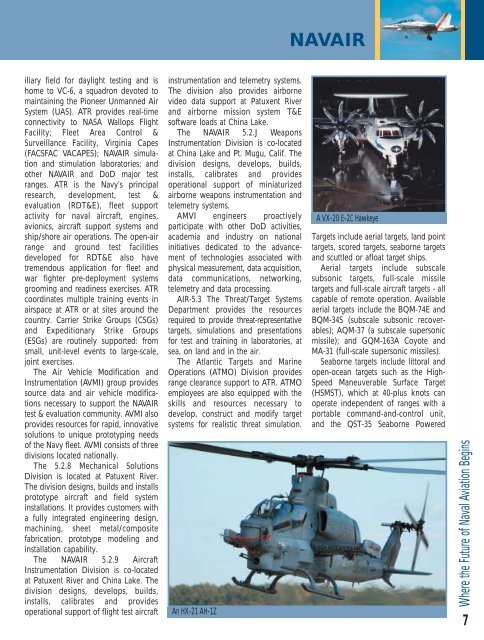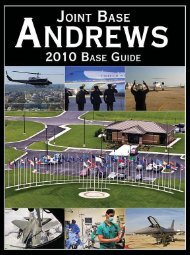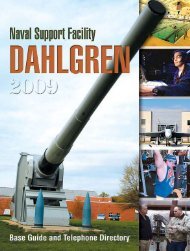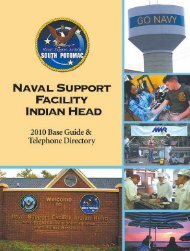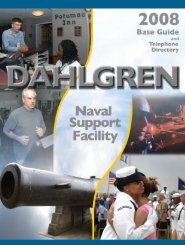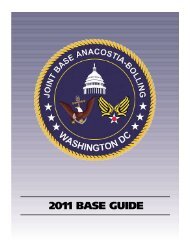About Naval Air Station Patuxent River - DCMilitary.com
About Naval Air Station Patuxent River - DCMilitary.com
About Naval Air Station Patuxent River - DCMilitary.com
Create successful ePaper yourself
Turn your PDF publications into a flip-book with our unique Google optimized e-Paper software.
iliary field for daylight testing and is<br />
home to VC-6, a squadron devoted to<br />
maintaining the Pioneer Unmanned <strong>Air</strong><br />
System (UAS). ATR provides real-time<br />
connectivity to NASA Wallops Flight<br />
Facility; Fleet Area Control &<br />
Surveillance Facility, Virginia Capes<br />
(FACSFAC VACAPES); NAVAIR simulation<br />
and stimulation laboratories; and<br />
other NAVAIR and DoD major test<br />
ranges. ATR is the Navy’s principal<br />
research, development, test &<br />
evaluation (RDT&E), fleet support<br />
activity for naval aircraft, engines,<br />
avionics, aircraft support systems and<br />
ship/shore air operations. The open-air<br />
range and ground test facilities<br />
developed for RDT&E also have<br />
tremendous application for fleet and<br />
war fighter pre-deployment systems<br />
grooming and readiness exercises. ATR<br />
coordinates multiple training events in<br />
airspace at ATR or at sites around the<br />
country. Carrier Strike Groups (CSGs)<br />
and Expeditionary Strike Groups<br />
(ESGs) are routinely supported: from<br />
small, unit-level events to large-scale,<br />
joint exercises.<br />
The <strong>Air</strong> Vehicle Modification and<br />
Instrumentation (AVMI) group provides<br />
source data and air vehicle modifications<br />
necessary to support the NAVAIR<br />
test & evaluation <strong>com</strong>munity. AVMI also<br />
provides resources for rapid, innovative<br />
solutions to unique prototyping needs<br />
of the Navy fleet. AVMI consists of three<br />
divisions located nationally.<br />
The 5.2.8 Mechanical Solutions<br />
Division is located at <strong>Patuxent</strong> <strong>River</strong>.<br />
The division designs, builds and installs<br />
prototype aircraft and field system<br />
installations. It provides customers with<br />
a fully integrated engineering design,<br />
machining, sheet metal/<strong>com</strong>posite<br />
fabrication, prototype modeling and<br />
installation capability.<br />
The NAVAIR 5.2.9 <strong>Air</strong>craft<br />
Instrumentation Division is co-located<br />
at <strong>Patuxent</strong> <strong>River</strong> and China Lake. The<br />
division designs, develops, builds,<br />
installs, calibrates and provides<br />
operational support of flight test aircraft<br />
instrumentation and telemetry systems.<br />
The division also provides airborne<br />
video data support at <strong>Patuxent</strong> <strong>River</strong><br />
and airborne mission system T&E<br />
software loads at China Lake.<br />
The NAVAIR 5.2.J Weapons<br />
Instrumentation Division is co-located<br />
at China Lake and Pt. Mugu, Calif. The<br />
division designs, develops, builds,<br />
installs, calibrates and provides<br />
operational support of miniaturized<br />
airborne weapons instrumentation and<br />
telemetry systems.<br />
AMVI engineers proactively<br />
participate with other DoD activities,<br />
academia and industry on national<br />
initiatives dedicated to the advancement<br />
of technologies associated with<br />
physical measurement, data acquisition,<br />
data <strong>com</strong>munications, networking,<br />
telemetry and data processing.<br />
AIR-5.3 The Threat/Target Systems<br />
Department provides the resources<br />
required to provide threat-representative<br />
targets, simulations and presentations<br />
for test and training in laboratories, at<br />
sea, on land and in the air.<br />
The Atlantic Targets and Marine<br />
Operations (ATMO) Division provides<br />
range clearance support to ATR. ATMO<br />
employees are also equipped with the<br />
skills and resources necessary to<br />
develop, construct and modify target<br />
systems for realistic threat simulation.<br />
An HX-21 AH-1Z<br />
NAVAIR<br />
A VX-20 E-2C Hawkeye<br />
Targets include aerial targets, land point<br />
targets, scored targets, seaborne targets<br />
and scuttled or afloat target ships.<br />
Aerial targets include subscale<br />
subsonic targets, full-scale missile<br />
targets and full-scale aircraft targets - all<br />
capable of remote operation. Available<br />
aerial targets include the BQM-74E and<br />
BQM-34S (subscale subsonic recoverables);<br />
AQM-37 (a subscale supersonic<br />
missile); and GQM-163A Coyote and<br />
MA-31 (full-scale supersonic missiles).<br />
Seaborne targets include littoral and<br />
open-ocean targets such as the High-<br />
Speed Maneuverable Surface Target<br />
(HSMST), which at 40-plus knots can<br />
operate independent of ranges with a<br />
portable <strong>com</strong>mand-and-control unit,<br />
and the QST-35 Seaborne Powered<br />
Where the Future of <strong>Naval</strong> Aviation Begins<br />
7


